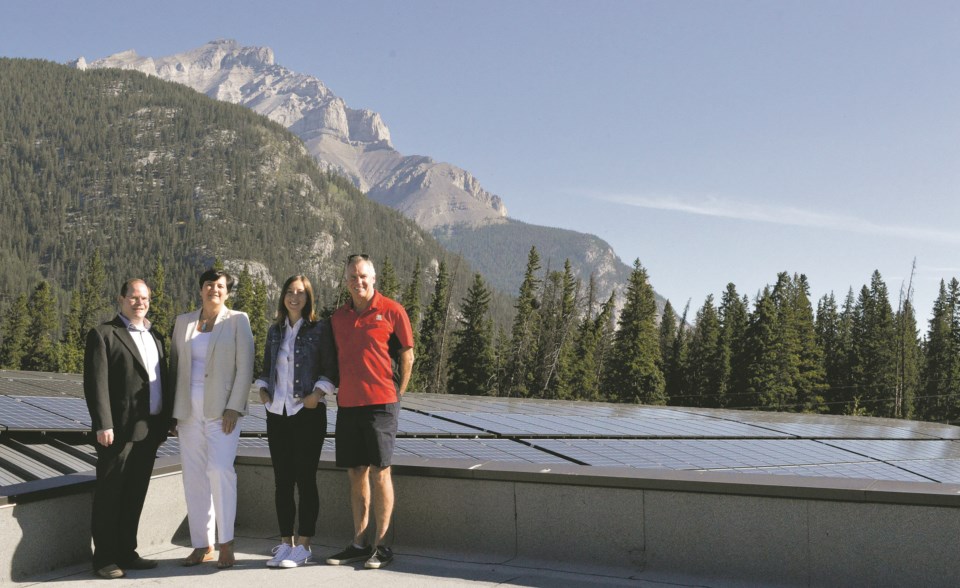BANFF – An ambitious new plan charts a path for Banff to do its part to tackle climate change.
On Monday (Dec. 16), council adopted its climate action plan, which contains 30 recommendations to meet Banff’s commitment to reduce greenhouse gas emissions by 30 per cent by 2030 and 80 per cent by 2050, and achieve 100 per cent renewable energy by 2050.
Town of Banff officials say the plan requires a $327 million investment over the next 30 years in buildings, transportation and renewable energy projects by both the private and public sector, but note there are an estimated $781 million in savings from reduced energy costs.
Councillor Chip Olver said the Renewable Energy Transition Roadmap is an ambitious, aspirational plan that’s been well researched, noting it is critical climate action plans outline both environmental and economic benefits as this one does.
“There is a return on investment and it is one of those lovely things where there’s co-benefits: you reduce greenhouse gases and you save money for much of what’s being proposed,” she said.
“It will be a challenge in the future … and I just look forward to seeing how we move forward in the next five, 10, 20, 30 years.”
The signs of global climate change are everywhere and scientists are confident that global temperatures will continue to rise for decades to come, largely due to greenhouse gases produced by human activities.
Locally, one of the most notable environmental changes is the dramatic rate at which glaciers are receding, including Peyto Glacier in Banff National Park, which has lost about 70 per cent of its mass in the last 50 years.
Banff’s plan calls for a dramatic expansion of renewable and low-carbon energy supply, as well as a major drop in energy demand, largely from a significant expansion of public transportation, full transition to electric vehicles and major improvements to building energy efficiency.
Recommendations include major retrofits of buildings throughout town for greater energy efficiency, significant expansion of local and regional transportation and major growth in solar photovoltaic power.
The plan also looks at generating heat and power from biomass or biogas, heat pumps for residential and commercial buildings, a district energy system with natural gas co-generation and local or utility-scale electricity storage.
Importing renewable energy is a key recommendation in the plan, which includes an option to directly buy renewable energy from wind and solar projects and/or in-kind purchase of renewable natural gas.
In 2016, the baseline year for Banff’s Renewable Energy Transition Roadmap, renewables provided less than one per cent of the community’s energy, but the plan sees this increase to 54 per cent by 2050.
“It’s an ambitious report,” said Michael Hay, the Town of Banff’s manager of environment and sustainability. “We’re trying to be leaders here; we’re trying to do better than anybody else.”
There are no funding requests at this time, but council has directed administration to prepare a work plan, including a price tag for 2021-22 based on the plan’s short-term recommendations, to be brought to council next service level review a year from now.
Hay said the average annual investment would be approximately $11 million.
But he said it’s worthwhile comparing this to the estimated $152 million spent by the community each year on energy alone, much of which is for transportation fuel used by visitors.
“These investments will rely on the tourism and hospitality industries, local institutions, residents, visitors, neighbouring municipalities and Parks Canada all taking up the challenge,” said Hay. “They will also depend on third party investment capital, affordable financing and private/public grants.”
According to the plan, Banff’s greenhouse gas emissions per capita are more than double the national average – 45 tCO2e/person vs. 19.5 tCO2e/person.
This is because GHG accounting rules require that permanent residents inherit a portion of visitor transportation emissions – and Banff welcomes about four million visitors a year.
Hay said the combined impact of all 30 actions in the plan is an 83 per cent reduction in community greenhouse gas emissions, which would achieve council’s greenhouse emissions reduction goal of 80 per cent by 2050.
“This is possible despite a projected 40 per cent increase in visitor-adjusted population, and a 13 per cent increase in gross floor area,” he said.
A complete path to 100 per cent renewable energy could easily have been modelled, Hay said, but this would have required very aggressive assumptions, and much greater investment.
“Achieving 100 per cent renewable energy would effectively make the community carbon neutral, a stretch goal that may become more achievable as the green economy evolves,” he said.
Mayor Karen Sorensen said it is clear that future councils will have a huge role to play in this.
“We get the easy part. We get to say we’re going to do this and this is important and we want to make a change and we want to be one of those municipalities who are really moving things forward,” she said. “I think it will be future council who will have to make financial decisions.”





